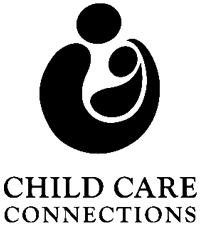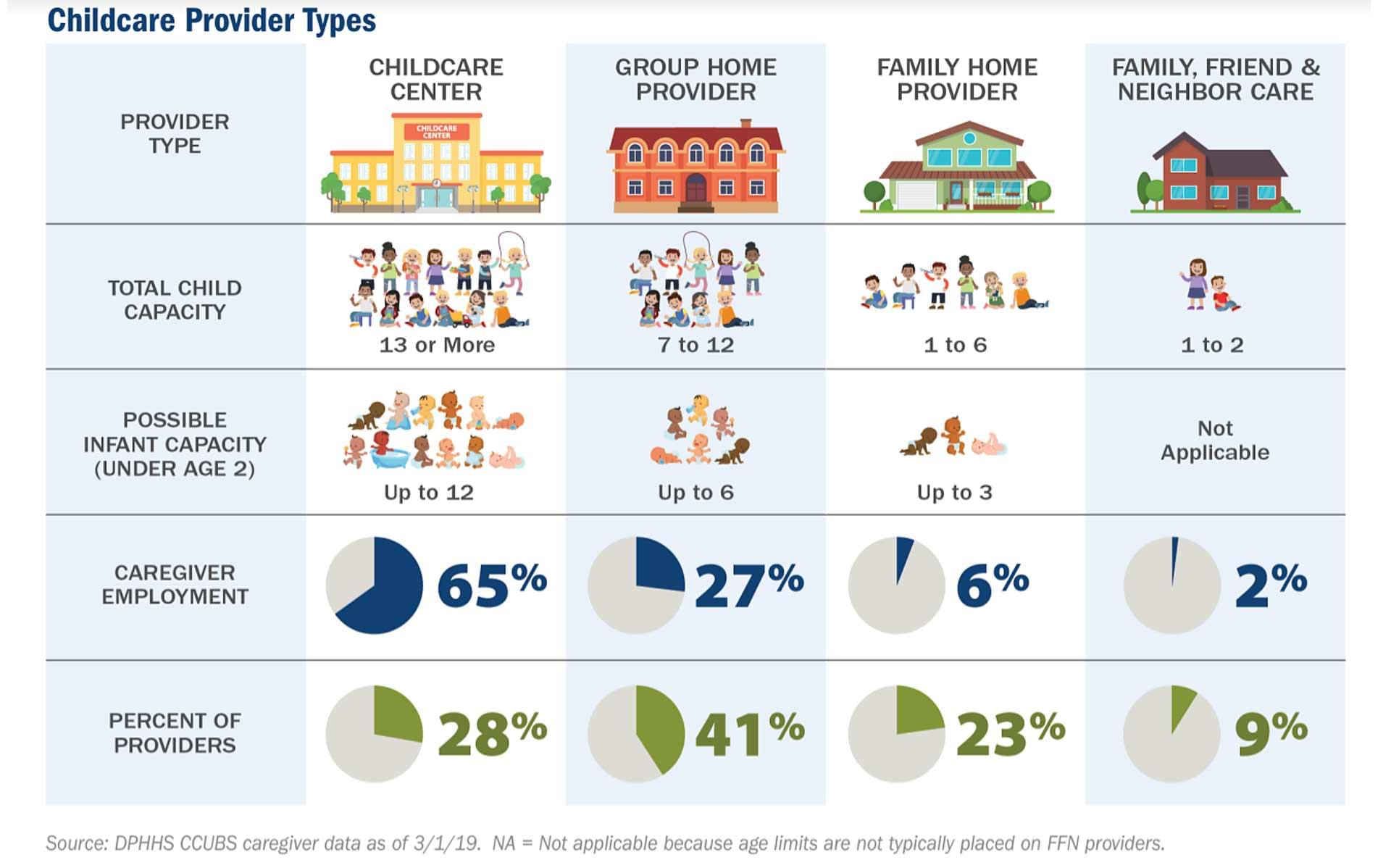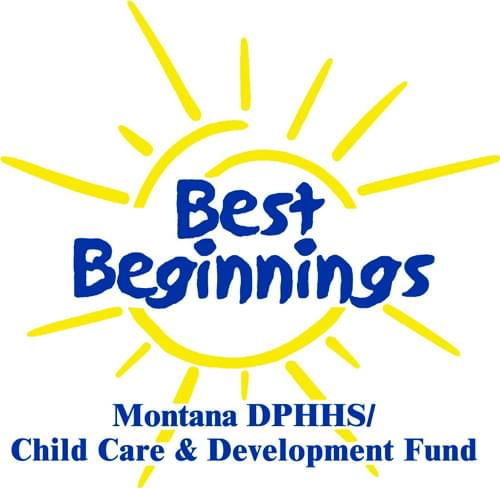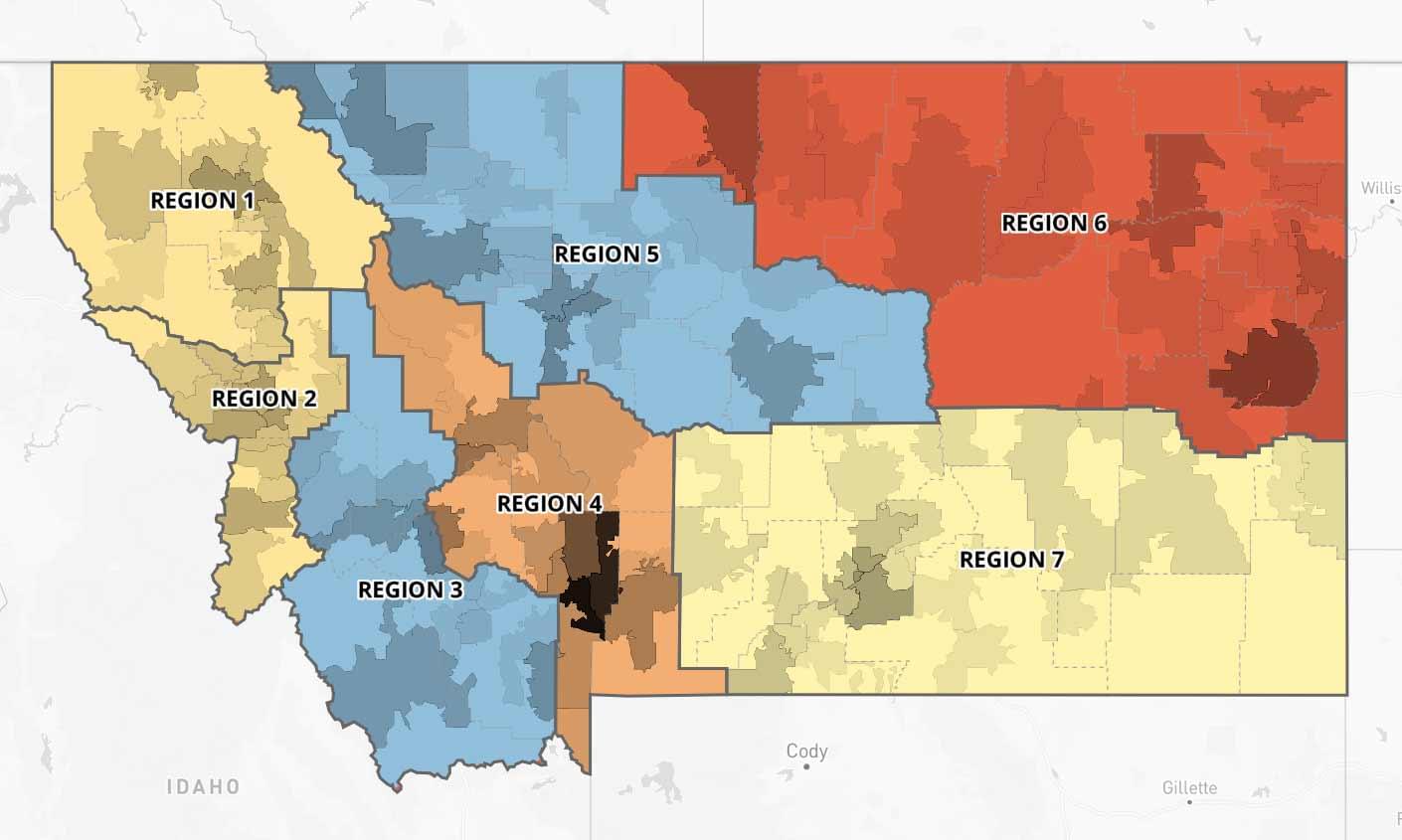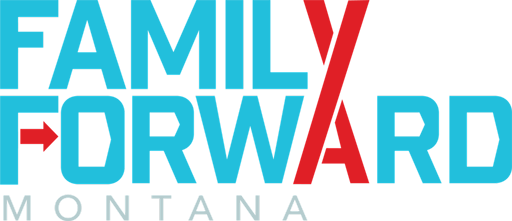Introduction
What is ENHANCE - Essential Child Care Needs COVID-19 and Beyond?
A collaborative initiative to address child care and out-of-school time care needs across the state of Montana. Due to COVID-19 school and business closures resulted in cascading effects to families, providers, businesses, and schools, which illuminated the fractured childcare system in Montana that existed before the pandemic. Child care access, affordability and dependability became a central factor in Montana's ability to respond, rebuild and re-open. ENHANCE has a mission to ensure Montana re-opens by addressing the cascading effects and resources needed across sectors, building sustainable systems and community resilience. In looking at the impact of COVID-19 through the lens of child care, a road map to respond and rebuild our state and nation is made clear - investing in child care infrastructure is critical.
Table of Contents
How to navigate this webpage
Use the navigation bar at the top of the page to keep track of which Chapter you are currently in. Clicking the Chapter title near the icon above will open the Table of Contents. Click the icon once again to close the Table of Contents menu.
The ENHANCE Survey
Overview
The ENHANCE statewide survey was designed by a collective led by the Montana VOAD (Volunteer Organizations Active in Disasters) Child Care Sub Committee in response to COVID-19. The sub-committee includes representatives from the various non-profit, volunteer, community and private sector organizations. As the state and businesses reopen, it is critical that the child care system be considered as an essential factor in its ability to best meet the needs of children, families, schools, providers, and the economy. The ENHANCE survey and recently published data sets help illustrate the complexity of these issues and areas of need to ensure the state’s stability during and post pandemic.
Scope of Data
The ENHANCE Survey was designed to assess the current state, impacts of COVID-19 and needs across sectors with an attempt to get a statewide response. The insights proposed by the analysis of the ENHANCE data, in combination with the more robust statistical analysis and assessment pre-COVID-19 by Bureau of Business and Economic Research (BBER) survey and data from DPHHS, provides a framework of which to apply to decisions moving forward.
The ENHANCE statewide survey resulted in 2,942 respondents representing Families (2,118 / 72%), Child Care Providers (426 / 14%), Businesses (138 / 5%) and Schools (260 / 9%). It is important to note that the survey responses were concentrated in more urban, populated regions of Montana and not equally distributed across the cohorts, meaning that there were more respondents representing parents and families than businesses and child care providers.
To provide more depth into how child care affects across sectors, we have incorporated the recently published findings from the BBER study titled “Lost Possibilities - The Impacts of Inadequate Child Care on Montana’s Families, Employers and Economy” (published in September 2020). This statewide survey was conducted in January - April 2020 to examine the economic impact that inadequate child care has on Montana parents, employers and taxpayers.
Number of Survey Respondents by Cohort
ENHANCE Survey, June 29 to July 15, 2020
Methods
Questionnaire Design
The Montana VOAD (Volunteer Organizations Active in Disasters) Child Care Sub Committee, in response to COVID-19, created a comprehensive survey to be distributed statewide to families, child care providers, businesses and schools. Questions reflected quantitative and qualitative metrics across focus areas of COVID-19’s impact on child care and included questions on demographics, financial needs and costs, social/emotional wellbeing, readiness and preparedness to respond.
Distribution
The surveys were shared by a network of organizations and partners associated with the VOAD group. Distribution included email and social media messaging and all data was securely housed at Montana State University. Geographic location, determined by zip-code, was collected for all respondents. The only identifying information of respondents provided was email addresses, which was voluntary. Identifying information was not shared.
Analysis
After the survey was closed, data was analyzed and shared on the ENHANCE website and through various webinars. Respondents who indicated an interest and provided an email address were invited via email to attend. A simple analysis of survey questions focused on the percentages of respondents per survey question. Analysis was used to illustrate trends around the impact of COVID-19 on child care as it relates to the four cohorts surveyed statewide - Parents/Families, Child Care Providers, Schools and Businesses.
Sampling
Data is not represented by a power analysis for statewide census and is not a comprehensive analysis of any single cohort represented.
Characteristics
The ENHANCE Survey response demographics reflect a majority of parents located in urban, more populated regions of Montana followed by Child Care Providers, Schools and Businesses - also primarily located in urban, populated regions.
Descriptive Analysis
The intent of the survey analysis is to illustrate the impact of COVID-19 across sectors, illuminate system gaps and sector intersections. It is the intent that the data guide policy and infrastructure solutions for child care in Montana. The results are not universally applicable.
Read moreCOVID-19 & Child Care
Why It Affects Every Aspect of Our Community Resiliency
To appreciate how child care drives our collective resiliency to COVID-19 it helps to look at different groups within our community - Families, Child Care Providers, Businesses and Schools. Below highlights what we learned from the ENHANCE survey and illustrates how child care is a thread that connects these groups.
Cascading Effects
The Importance of Child Care
The COVID-19 crisis has made clear that child care is a critical service that enables families, communities, and businesses to function effectively.
What is it about Child Care? Why has COVID-19 shed a light on what is normally a personal issue?
School Closures
School closures and shelter in place orders disrupted the normal homeostasis of our communities. Kids were sent home, parents laid off, furloughed or shifted to work from home and parents who are essential workers were challenged with taking on health risks in addition to managing family responsibilities. All while changing regulations, health updates and progress was made to control the spread of the pandemic.
Stress, anxiety, financial burdens and health risks were not only challenges for parents. Businesses and Schools were dramatically impacted by closures and reopening our economy posed new challenges - capacity restrictions, staff shortages, increased costs and uncertainty about what lies ahead.
Limited Child Care Providers
Child Care providers are a unique business sector vulnerable to COVID-19 due to enrollment being the source of revenue: slim margins with added costs and low payments - all disrupted by COVID-19. 44% of Montana’s children needing care could be served by the pre-pandemic early care and education capacity. Children needing care in this context is defined as a child under six with all parents in the workforce. Since the onset of the pandemic, Montana has seen a reduction in available child care of 3%. Child care providers did not have options to pivot services like other industries, the entire business model was threatened by COVID-19, yet the demand for care providers was heightened.
Statewide the child care community responded as best they could, emergency pop-up facilities and extended hours were some of the ways providers responded but over time added restrictions led to added costs and with capacity limitations, enrollment and revenue for providers was reduced making it challenging to stay open to support the growing demand. As COVID-19 spread across the state licensed child care facilities capacity was impacted. In most regions capacity was reduced, however in others it increased but only with an average of 1-2 newly added child care providers. It is important to note that an increase in licensed capacity does not necessarily correlate with an improved ability to meet the need. Previously unlicensed programs, such as Head Start programs, may have become licensed during this time, impacting the number of licensed capacity, but not impacting the availability of care for families. Statewide, Montana lost 3% of total licensed child care capacity. COVID-19 increased the already difficult task of retaining and recruiting staff. This growing concern coupled with limited group sizes reduced the actual number of available child care slots even further despite the growing demand.
Statewide, Montana lost 3% of total licensed child care capacity.
If Child Care is Supported
How would our initial and long term response to COVID-19 be different if child care was not a factor? Would our essential workers be able to consistently respond with less stress and anxiety about the safety of their children? Would child care providers be able to surge capacity for emergencies without compromising quality and safety of care? Would schools and community providers work hand in hand with local businesses to coordinate and provide services in times of need? Would businesses offer benefits for employees that incorporate creative child care solutions like on-site child care, more flexible Family Medical Leave of Absence (FMLA) and flexible spending accounts to subsidize child care? In retrospect what would the state of our economy look like? How secure would our communities be if businesses and employment levels were stabilized?
Affordability
Families, Essential Workers, and School Closures
Without having a stable child care infrastructure to support families, especially essential worker parents - community and economic resiliency is fragile. Parents are faced with making critical decisions for the safety and wellbeing of their children weighed against the financial stability of their family. These are impossible choices. Without an appreciation of how these challenges relate to one another, families will remain vulnerable and at risk having an unknown long term impact on our state’s workforce and tax revenue potential. Ultimately this affects all Montanans.
Family Insights
Typically young families with children under 5 experience a termed impact on their ability to continue in the workforce - meaning short term child care solutions until children reach school age. BBER reported that 73% of Montana households with children ages 0 to 5 years old require some form of child care arrangement away from home to allow for all available wage earners to earn a paycheck. This personal investment of families is typically until school begins.
The statewide response to close schools and implement shelter - in - place orders had an obvious impact on parents with children, particularly those who are essential workers. Not only did these parents have to design solutions to meet the needs of their children, those solutions were needed immediately in order to be able to work and support essential services. Under normal circumstances after school programs, summer camps and day-care facilities can surge capacity but in light of the nature of COVID-19 these options were not practical, safe nor even an option per national and state immediate guidelines. Parents had to make tough choices about leaving children home either without supervision or relying on family members, friends or paying for child care.
Essential workers struggled to find child care, some making tough choices to leave children home alone.
Families, Essential Workers and School Closures
With COVID-19 having an impact on schools ability to re-open the number of families impacted extends beyond those with very young children - it impacts all families with children, even those with teenagers. What is normally a short-term personal investment is now a longer term and more economically devastating impact on families as well as the community economy.
Child care issues pre-COVID-19 affected parents ability to work in a variety of ways, all leading to a loss of productivity and income as BBER reported that parents in the last month experienced the following child care-related work problems (pre COVID-19) 46% left work early, 44% missed a full day of work, 41% were distracted or less productive at work, 37% were late for work and 36% were absent (BBER). Without having a stable child care infrastructure to support families, especially essential worker parents - community and economic resiliency is fragile. BBER reports that due to inadequate child care individual households have an average financial burden of $5,700, a statewide total burden of $145,146,000 to households in 2019.
Without having a stable child care infrastructure to support families, especially essential worker parents - community and economic resiliency is fragile.
Critical Decisions
Parents are faced with making critical decisions for the safety and wellbeing of their children weighed against the financial stability of their family. These are impossible choices. Without an appreciation of how these challenges relate to one another, families will remain vulnerable and at risk having an unknown long term impact on our states workforce and tax revenue potential ultimately affecting all of us.
Accessibility
Child Care Providers - An Essential Business
Child care is not naturally categorized as a "business", yet providing child care professionally is a business and child care businesses are uniquely impacted by COVID-19. Capacity restrictions, added sterility, safety and PPE supply costs, fluctuating and increased demands have all contributed to challenges faced by providers.
Child Care Educators
As school districts moved to distance learning earlier this Spring, many families utilized child care programs to care for their school aged children in order for parents to be able to continue to work. While many child care educators are experienced at caring for older children, supporting school aged children with online school work requires increased one-on-one support, altering the day to day programming. In anticipation of reduced classroom time for school aged children this fall, child care educators face restructuring their programs in order to meet the needs of children they serve.
Online learning and hybrid school schedules are challenging care providers to support tutoring with limited resources
Child Care is Critical
As our state looks to make decisions about economic recovery, our success depends on including child care as a critical component of our plans to meet the changing needs of children, families, and employers.
Funding
The Dollars and “Sense” of Child Care
Federal tax dollars to support child care subsidies are primarily restricted to state block grants that fund the Best Beginnings Scholarship (BBS). BBS funds are made available to families who are working or attending school and earn less than 150% of the Federal Poverty Level.
Co-payments
Family income is evaluated for eligibility and a copayment is determined based on the Child Care Sliding Fee Scale. Co-payments begin at ten dollars ($10), and increase depending on family size and income. Income eligibility is determined by adding all income sources together.
Montana Median Household Income, 2018
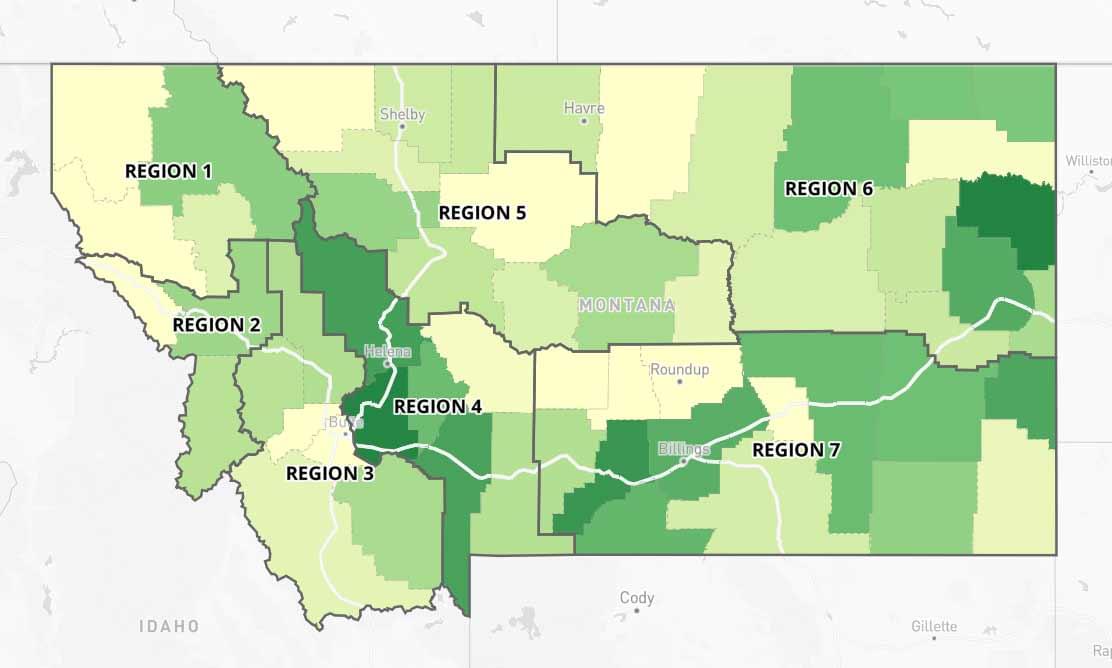
Montana Median Household Income, 2018
Legend
Child Care Challenges
For those that do not qualify for a Best Beginnings Scholarship, child care is an out of pocket expense families must absorb. BBER found that 57% of households reported that finding affordable child care is a challenge and 41% reported that finding back-up care, emergency care, or care for a child who is sick is challenging. BBER compared the average annual child care expenditures per household to the percentage of median household income and found that the overall expenditures averaged $4,850 - roughly 8% of household income. It’s important to emphasize that this expenditure is annual and repeated expenses year after year.
57% of households reported that finding affordable child care is a challenge.
The Ins and Outs of Best Beginnings Scholarships
Montana distributes the Best Beginnings Scholarship via regional Child Care Resource & Referral agencies. Families who qualify can identify a licensed child care provider through these agencies. COVID-19 CARES Act Relief Funds covered 100% of copayments for families for the months of March, April, and May 2020 and by reimbursing providers at 100% of the authorized amount of care for those same months regardless of attendance. As of July 2020 Montana had distributed $1,419,479 in Best Beginnings Child Care Scholarship support.
Families that qualify for the income eligibility must also be participating eligible activities:
-
Two-parent families shall work at least 120 hours per month.
-
Single-parent families shall work at least 60 hours per month.
-
Single parent or two-parent families in which all of the parents attend school/training full time, do not have to meet a work requirement.
-
Single parent or two-parent families in which one or more of the parents attend school/training part time shall meet a work requirement that takes into account the education/training.
-
Teen parents must be attending high school or a high school equivalency program.
Best Beginnings Scholarship Reach
The Best Beginnings Child Care Scholarship only reaches about 25% of eligible families. Additionally, COVID-19 CARES Act Relief Funds supported licensed child care providers in Montana, by distributing grants totaling between $3,000 and $26,500 based on size of program to 818 providers.
ENHANCE’s advocacy work contributed to an additional $50M of block grant funding to be allocated for Child Care in the below ways:
-
$30 million in grants to maintain and expand child care for school-age children during out of school time.
-
$10 million for families with special circumstances requiring in-home care.
-
$8 million for supplemental payments to all licensed and registered child care facilities to maintain and expand child care slots.
-
$2 million for CCR&R agencies for administration and outreach.
Best Beginnings Child Care Scholarship only reaches about 25% of eligible families.
Special Circumstance Child Care Scholarships by County
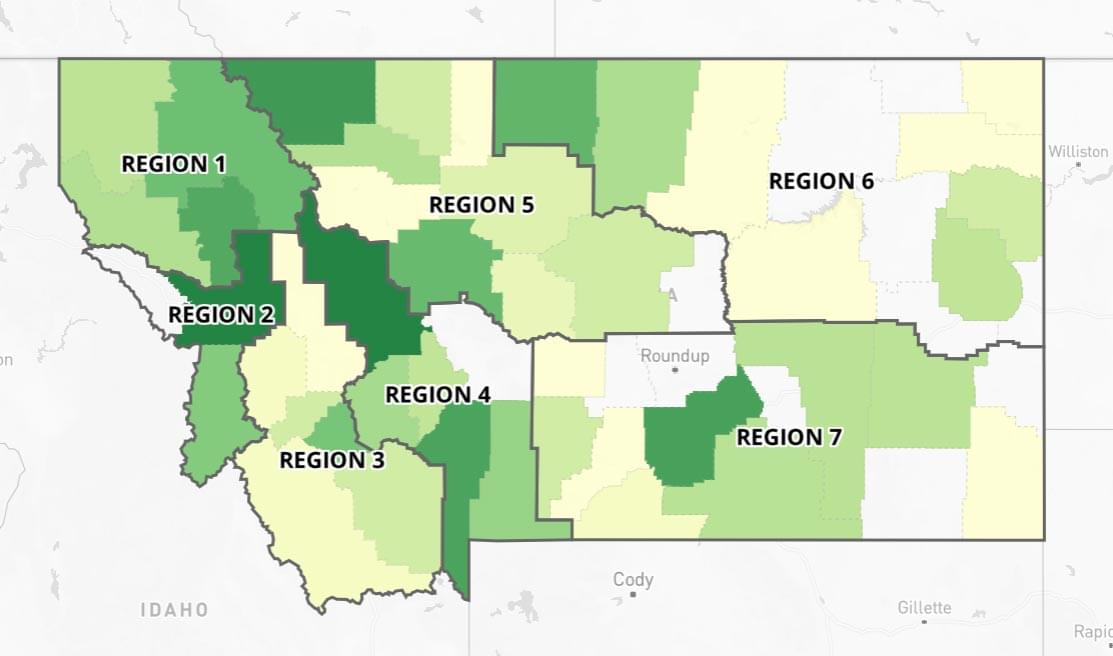
In Home Special Circumstance Scholarship Grant Awards by Child Care Region
Legend
Lewis & Clark County: $1,092,000
Missoula County: $1,012,000
Glacier County: $748,000
Yellowstone County: $668,000
Gallatin County: $632,000
Rates & Reimbursements
Outside of COVID-19 CARES Act Relief for distribution of BBS, providers submit an invoice to the state documenting the child's attendance, and are paid by the state accordingly. Payment to providers is also dependent on the type of license the provider holds in addition to the age of the child and whether they attend a full or half day. Parents are responsible for the sliding scale co-payment which would be paid directly to the provider. The state uses a standard reimbursement fee based on the age of child (infant/toddler, pre-k, school aged) and whether the child attended the program for a full day or half day (Full day= more than 6 hours, Half day= 6 hours or less). This ranges between $10-40 per day. Parents would be asked to provide the difference in tuition if there was one. Some high quality programs do not accept Best Beginnings Scholarships because they can fill their slots with private paying families at a higher rate than the scholarships reimbursement.
COVID-19 highlighted how the historically limited investment in child care as a common - public good correlated with our collective ability to respond and our limitations to meet the demand. It required a significant amount of advocacy and reliance on aid funding to ensure at least in the immediate response to COVID-19 child care services would be available.
COVID-19 highlights the repercussions of the historically limited public investment in child care.
Market Failure
Child Care Market Rates
Child care exists in a market-based system, however, market rates do not reflect the true cost of providing high-quality child care - they reflect what families can afford to pay. Child care providers often absorb the difference between the actual cost of care and what the market pays. This is reflected in their low salaries, razor-thin margins and minimal, if any financial reserves.
The Iron Triangle
In order for child care programs to be financially sustainable they must live by what is called the Iron Triangle, they must strive for full enrollment every day, collect tuition on time and in full, and match annual revenue to expenses. Since the pandemic, nearly every child care program in Montana has had at least one, if not all three, of these elements at risk. Providers operate with thin margins and even one month of missed income, or an unexpected decrease in enrollment can be catastrophic.
-
Top 3 contributors to added costs for Providers: 1-Sterility & Safety Precautions 28.25%, 2-Reduced Capacity 20.25%, 3-Education & Training 11.38%
The National Association for the Education of Young Children in early March conducted a national assessment to understand the early effects of the Coronavirus on Child Care providers. The report released March 27, 2020 titled “A State-by-State Look at Child Care in Crisis - Understanding Early Effects of the Coronavirus” found that in Montana, of the 130 providers who responded:
-
34% say they would not survive closing for more than two weeks without significant public investment and support that would allow them to compensate and retain staff, pay rent, and cover other fixed costs.
-
24% would not survive a closure of any length of time without these supports
-
15% do not know how long they would be able to close their doors and be able to reopen without these supports › 52% have parents who cannot pay fees or copays
-
49% have lost income because they are paid by attendance rather than enrollment and 64% have lost income based on families’ own inability to pay.
-
Note that 19% of responses in Montana are from those working in community-based centers and 70% are from those working in family child care homes.
Child Care exists in a failed market-based system not covering the true cost of care
Coordination
Learning in time of COVID-19
In a typical disaster (Flood, Hurricane or Earthquake) schools provide acute shelter but longer term services are supported by churches, charities (ie Red Cross, United Way). As COVID-19 is not a typical disaster (ie - there is not a defined and predictable term or duration, boundary of affected area, or population affected) the typical disaster responses don’t match the need.
School Closures and Child Care
In addition to educating the next generation schools provide essential services for families in need such as food, crisis intervention, the surveillance and reporting of domestic violence child abuse. With school closures and the unpredictability in plans for '20-'21 these critical services are impacted having long term and lasting effects on families and the community. There is an opportunity for schools to play a critical role to ensure that these services are provided in addition to collaborating with providers in their community to support child care needs. Communication of school plans and services will be critical as plans remain unpredictable leading into flu season on top of the pandemic and resurgence of outbreaks. For example, Missoula County has developed collaborative tools to connect care options by school to support families. Montana Afterschool Alliance has created a database for parents to search for care options based on location to facilitate connecting families to resources. Creative solutions and coordination of services will be critical for schools to recover financially even with government subsidies.
Timely communication of school plans is critical for communities to be able to respond to child care needs.
Support is Needed
Schools will need significant financial support moving forward. An appreciation from schools on how their schedules support or hinder parents ability to work will be critical to the overall ability for communities to rebuild. Communication will be key to ensure timely distribution of critical information. The hybrid and virtual learning models will undoubtedly have an effect on this generation of Montanans, it will be important to monitor how this impacts learning long term.
Businesses and Economic Resiliency
Montana’s essential businesses struggled to manage the same or increasing demands for services as COVID-19 posed increased risks for employees to continue to work. Those with children had added challenges once schools were closed to manage child care and maintain their availability to work. As the state reopens and restrictions are lifted not only do essential businesses remain open but all other businesses are attempting to reopen in order to rebuild the economy.
The economic impact of COVID-19 on businesses is profound
According to BBER Montana businesses bear the burden of inadequate child care, mainly from reduced revenue due to lower employee productivity and increased employee recruitment costs caused by unwanted employee turnover. These factors were only exacerbated by COVID-19, school closures and reduced access to child care services. Although ENHANCE was unable to quantify the total economic impact on businesses BBER reported that in 2019 the total economic loss to Montana businesses was $54,562,000 due to child care-related problems.
BBER reported that in 2019 the total economic loss to Montana businesses was $54,562,000 due to child care-related problems
The dependencies of our economy to rebuild are directly related to our businesses being able to remain open and grow. This is only possible if employees are able to work and for employees with children not having child care impede their ability to work.
The “Work” in Working From Home
Many businesses maintained employment during COVID-19 by pivoting operations for employees to work from home. For employees with children the ability to efficiently and effectively work from home is compounded by child care responsibilities and with ‘20-’21 school year plans including virtual learning parents struggle to maintain these conflicting obligations.
-
One Business respondent stated “Increased demand for our services, staff that do not have child care or school, now have to be at home AND be education teachers for their kids, while also being employees. Not sustainable”
-
One parent respondent stated “At some point one of us will likely have to opt out of the workforce. We cannot effectively homeschool our children while trying to work full time. Neither of us would like to stop working but may be forced to without enriching and educational activities for our children.”
For parents working from home without child care is not a solution
It is in the best interest of employers to be proactive in identifying child care needs of their employees and perhaps ways in which various benefits could support these needs without the loss of employee efficiency and turnover. Businesses can collaborate with community organizations and work with school districts to support creative solutions such as co-op child care partnerships, work-family balance policies on site child care as well as flexible scheduling arrangements and connecting employees with community resources.
Family Forward Montana
Family Forward Montana strengthens businesses in their commitment to children, families, and the future of Montana’s economy through practices which benefit both businesses and their family connected employees. A tiered pathway for employers toward improved workplace productivity, recruitment, and retention makes sense for everyone. Joining forces in this work while supporting children’s healthy development not only makes the workforce of today stronger, but also builds the foundation needed for the workforce of tomorrow to succeed.
Businesses who adopt family friendly policies see an increase in:
-
Employee Engagement
-
Employee Retention
-
Workplace Productivity
Provider Testimonial
A Child Care Business Supporting its Own Child Care Needs
Child Care Connections is a 501(c)(3) nonprofit that serves as the only child care resource and referral agency in Gallatin, Park, Meagher, Broadwater, Jefferson, and Lewis and Clark Counties. They support families and the local economy by encouraging quality child care and safety. They have 18 full time employees. As a business, Child Care Connections has pivoted to support staff who have children in the following ways:
-
Dependent Care Assistance Program (DCAP) reimbursement
-
Hired a temporary, part-time tutor to help staff’s children fulfill online learning obligations in the training room with access to supplies
-
Offers flexible scheduling to meet school and child care needs of staff including up to 2 days a week can be worked from home with the stipulation that working from home is not a replacement for child care
-
Children can be present in the office provided they pass the same employee health screen, wear masks in shared spaces, and are not disruptive to other staff
It is in the best interest of employers to be proactive in identifying child care needs of their employees
Chronic Stress
Stress, Anxiety, & Mental Health
Stress in the home due to COVID-19 is compounded by increased anxiety, mental illness, addiction and abuse amongst some families. Domestic violence and child abuse has gone under reported as schools have been closed due to COVID-19.
Increased Risk in the Home - ACEs & COVID-19
This does not mean the rate of abuse has decreased, just that the oversight and reporting of abuse has been arrested with school closures. These stressors amongst others are known as Adverse Childhood Experiences (ACEs) and they have a tremendous impact on future violence victimization and perpetration, and lifelong health and opportunity. ACE prevention and intervention are critical to the overall wellbeing of our communities.
The CDC defines ACEs, as potentially traumatic events that occur in childhood (0-17 years). For example:
-
experiencing violence, abuse, or neglect
-
witnessing violence in the home or community
-
having a family member attempt or die by suicide
Also included are aspects of the child’s environment that can undermine their sense of safety, stability, and bonding such as growing up in a household with:
-
substance misuse
-
mental health problems
-
instability due to parental separation or household members being in jail or prison
ACEs are linked to chronic health problems, mental illness, and substance misuse in adulthood. COVID-19 has contributed to increased rates of ACEs in the home.
Domestic violence and child abuse has gone under reported as schools have been closed due to COVID-19.
CDC Data on ACEs
ACEs are common. About 61% of adults surveyed across 25 states reported that they had experienced at least one type of ACE, and nearly 1 in 6 reported they had experienced four or more types of ACEs.
Preventing ACEs could potentially reduce a large number of health conditions. For example, up to 1.9 million cases of heart disease and 21 million cases of depression could have been potentially avoided by preventing ACEs.
Some children are at greater risk than others. Women and several racial/ethnic minority groups were at greater risk for having experienced 4 or more types of ACEs.
ACEs are costly. The economic and social costs to families, communities, and society totals hundreds of billions of dollars each year.
ACEs can have lasting, negative effects on health, well-being, and opportunity. These experiences can increase the risks of injury, sexually transmitted infections, maternal and child health problems, teen pregnancy, involvement in sex trafficking, and a wide range of chronic diseases and leading causes of death such as cancer, diabetes, heart disease, and suicide. ACEs and associated conditions, such as living in under-resourced or racially segregated neighborhoods, frequently moving, and experiencing food insecurity, can cause toxic stress (extended or prolonged stress). Toxic stress from ACEs can change brain development and affect such things as attention, decision-making, learning, and response to stress.
Children growing up with toxic stress may have difficulty forming healthy and stable relationships. They may also have unstable work histories as adults and struggle with finances, jobs, and depression throughout life. These effects can also be passed on to their own children. Some children may face further exposure to toxic stress from historical and ongoing traumas due to systemic racism or the impacts of poverty resulting from limited educational and economic opportunities.
Read moreTestimonial
Food Insecurity in the BlackFeet Nation
An unexpected need that has arisen is food. Already located in a food desert, the Blackfeet Nation, under strict stay-at home orders, is able to deliver food parcels by request through their Incident Command. However, for daily needs, the food budget has doubled for most families due to two things:
-
Most families relied on two meals per day from schools, year-around
-
Due to the rural and economically depressed location, grocery costs are very high.
Compound that with most services such as TANF and SNAP being offered sporadically or not at all, in response to a continuous spike in COVID-19 cases. Assessment of the Blackfeet Nation through a Family Special Circumstances grant offered from September - December 2020 provided firsthand accounts of food insecurity. Families detailed over and over that they lacked two things: food and internet service, important to note all schools and preschools are remote learning in the Blackfeet Nation. Schools may not typically be considered a source of food but for remote communities they play an important role for families in need. The tribal nations prior to COVID-19 were disportionately at risk and this is just one example of how the cascading effects of COVID-19 added to this risk by increased food insecurity.
Tribal nations were disproportionately at risk of food insecurity due to school closures.
Stress, Anxiety, & The Workplace
The health implications of ACEs may not seem to outweigh the immediate physical health risks of COVID-19 but the long term impact of ACEs on our statewide community and economy must be addressed and prevented. Creating and sustaining safe, stable, nurturing relationships and environments for all children and families can prevent ACEs and help all children reach their full potential. Schools reopening and access to child care services all contribute to prevention and reinforce the reporting and accountability infrastructure for ACEs interventions.
CDC recommendations for preventing ACEs align with solutions that address the cascading effects of COVID-19 on child care.
Strengthening the economy through family friendly business policies
-
Economic support to families improved household financial security and are reinforced by family friendly work policies.
-
As the economy rebuilds, businesses can directly impact families as well as reduce risks to employees.
-
Innovative policies include providing on-site child care services when possible, flexible work schedules, teleworking options, flexible spending accounts and increased paid time off. These policies lead to employee efficiency, retention and overall productivity of businesses. Montana’s Zero to Five - Family Forward initiative has put together best practice resources for businesses.
Reinforcing and enhancing child care capacity:
-
Ensuring a strong start for children through high-quality child care and preschool enrichment with family engagement.
-
Connect youth to caring adults and activities through increased access to mentoring and after-school programs
Improved communication and collaboration amongst schools, community organizations and child care providers:
-
Leadership is key to early intervention to lessen immediate and long-term harms through the education of providers and teachers in trauma intervention and social emotional learning principles.
-
Zero to Five has a creative toolkit to support collaboration for care.
Call to Action
Child Care and Montana’s Workforce
Pivoting options for businesses may not be suitable nor universally available across sectors but show an example of how leaders can work with employees' needs to maintain services. High cost, limited availability, and inconvenient program hours are all challenges that are driving parents out of the workforce.
The Costs of Child Care
There is a market failure when it comes to child care, most parents are unable to afford child care services and child care providers struggle to make a living wage to offer services yet the demand for child care remains and is growing. In light of COVID-19 child care providers that were able to remain open now have added stresses to their business models due to reduced capacity restrictions, added supply costs and challenges with staff recruitment. Statewide our ability to attract families, retain and attract workers and rebuild our economic resiliency will remain limited if we fail to acknowledge the cost associated when child care is not part of the solution. BBER reported the economic loss caused by inadequate child care for 2019 with a total loss to households of $145M, loss to businesses of $55M and loss to taxpayers of $32M. This is an annual cost of $232M to the Montana economy. It costs families, communities, businesses and ultimately every tax payer in the state.
Bureau of Business and Economic Research (BBER)
There is an opportunity to re-imagine the future state of Montana, even in light of COVID-19 and the uncertainty with school year plans. The costs will continue to mount if we fail to recognize the public concerns and common interests in establishing a resilient and robust child care infrastructure for our state. COVID-19 spikes in the community leading to shelter in place orders further stresses this fragile infrastructure. CARES Act funding ends at the end of the year and the essential workforce, including child care providers are fatigued. The system is not set up for resiliency and emergency response systems are meant to react to short term disasters not a long term pandemic.
There is a market failure when it comes to child care
Montana Tax payers lose $32M annually due to inadequate child care
Child Care Connections Fact Sheets
Child Care Connections, in early 2019, prior to COVID-19 released a series of useful resources for employers outlining steps they can take to explore child care solutions for their employees. These resources are even more valuable now as leaders navigate their operations in response to COVID-19.
The Time is Now
As we look beyond COVID-19, ENHANCE is committed to supporting the communities, organization and leaders to invest in child care. Join us as we continue to monitor, collaborate and communicate new data and resources on this site.
Resources
Resources - Toolkits and Links
Below is a subset of recently released information and links to various data sets and references mentioned in addition to the ENHANCE data.
Web Resources
Child Care Connections Fact Sheets, 2019
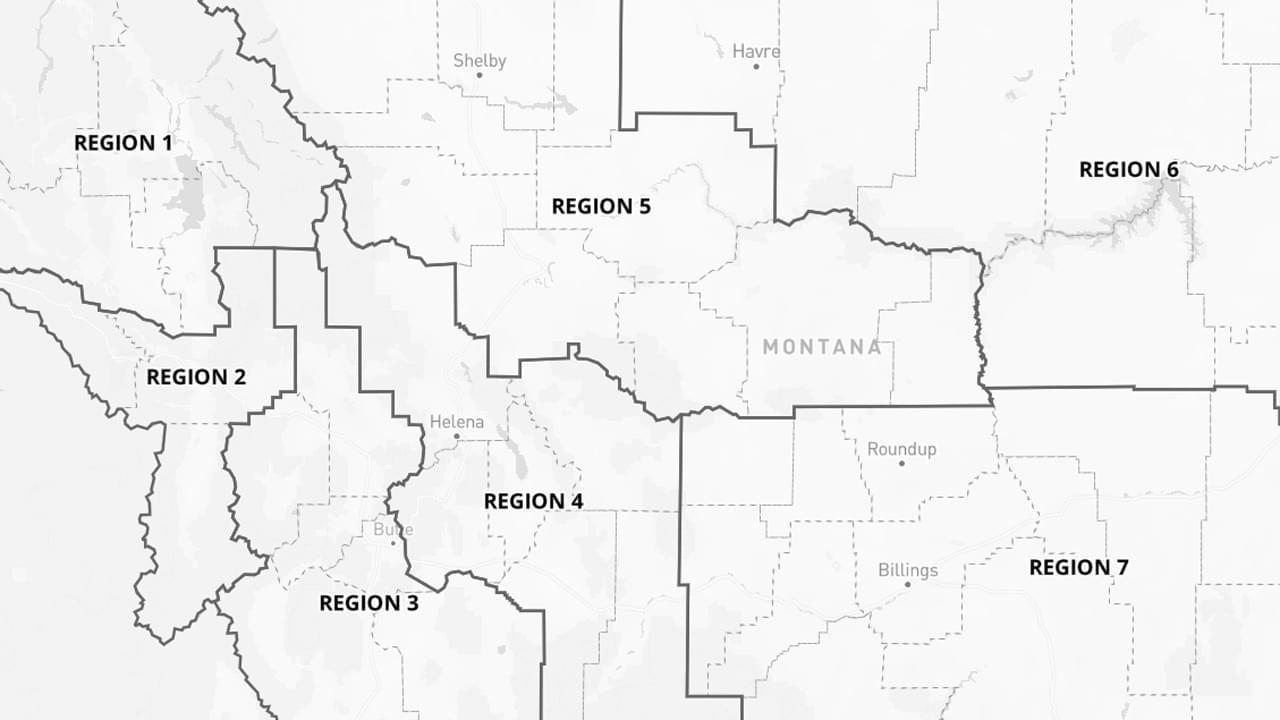
Downloadable Reports
- Child Care of America - Picking Up the Pieces: Building A Better Child Care System Post COVID-19
- Child Care Connections - Employer Supported Child Care
- National Association for the Education of Young Children March 27, 2020 “A State-by-State Look at Child Care in Crisis - Understanding Early Effects of the Coronavirus” (March 27, 2020)
- Zero to Five - Family Forward Initiative Family Forward Montana Business Practices and Policies 5/29/2019 Business Leader Summit Review Document
- Montana Early Learning Standards
- Montana’s Early Childhood System A Comprehensive Statewide Needs Assessment (September 2019) by Kristin Bloom Rporting to Montana Department of Public Health and Human Services, Early Childhood Services Bureau
Websites and Resources
- Burearu of Business and Economic Research (BBER)
- Search for Montana Coronavirus Relief Award Grants
- Child Care Aware of America
- Child Care Aware of America - Picking Up the Pieces: Building a Better Child Care System Post COVID-19 Interactive Website
- Zero to Five Data Dashboard
- Zero to Five COVID-19 Resources
- National Association for the Education of Young Children NAEYC A State-by-State Look at Child Care in Crisis: Understanding Early Effects of the Coronavirus (March 27, 2020)
- MT Child Care Resource and Referral Network - Homebase Child Care Toolkit
- Economic Policy Institute “The Cost of Child Care in the United States”
- Montana Kids Count
- Montana After School Alliance Database
Media
- Voices of Montana - Interview 9/23/20 with Lost Possibilities: The Impacts of Inadequate Child Care on Montana's Families, Employers and Taxpayers
- Bozeman Daily Chronicle: Report: Lack of child care in Montana impacts families, businesses, economy By Melissa Loveridge, Chronicle Staff Writer (Oct. 8, 2020)
References
- BBERS Full Report - Lost Possibilities: The Impacts of Inadequate Child Care on Montana's Families, Employers and Taxpayers
- Montana Department of Labor and Industry - Childcare in Montana: Supporting Montana Families and Caring for the State’s Most Precious Resource by Amy Watson, Senior Economist (September 2018)
- Montana Department of Labor and Industry - Montana Economy at a Glance: Understanding the Childcare Workforce: A critical component to addressing the states workforce shortage by Amber Watson, Senior Economist (April 2019)
- Montana DPHHS Covid-19 Impact on Child Care Capacity
- CDC - Adverse Childhood Events
- Montana Median Household Income Statistics
- Economic Policy Institute
- Federal Poverty Index
- Childcare Connections - COMMUNITY IMPACT OF CHILD CARE - Chamber Presentation Lewis and Clark
- DPHHS - Best Beginnings Scholarship
- A Brief History of Federal Financing for Child Care in the United States by Andy Cohen The Future of Children FINANCING CHILD CARE Vol. 6 No. 2 – Summer/Fall 1996
Acknowledgements
Acknowledgment of Support
We greatly appreciate the support and contributions for the ENHANCE initiative and statewide survey. Special thanks to the following organizations for their support:
-
Greater Gallatin United Way and One Valley Community Foundation provided funding through a grant from the Southwest Montana COVID-19 Response Fund,
-
Healthy Mothers Healthy Babies provided funding for editing costs,
-
Montana State University collected and analyzed survey results,
-
sciGaia contributed funding and staff to manage and build the ENHANCE platform,
-
State of Montana for supporting our work through the Business Innovation Grant Program.
Collaborators and Advocates
ENHANCE Ambassadors and Members of the Montana Volunteer Organizations Active in Disaster - Subcommittee on Child Care
-
A data driven software company that builds decision making platforms for pressing problems with the ultimate goal of creating solutions for sustainable wellbeing. SciGaia led the design of the survey, supporting the stakeholder groups and is hosting the platform for dissemination of the survey results.
Amber Caldwell — Health Strategist
Gary Gannon — Founder & Managing Director
Sean Gannon — Visual Communications
-
Montana Child Care Resource & Referral Network
Montana Child Care Resource and Referral Network unites Montana’s six Child Care Resource and Referral Agencies and coordinates efforts to build a high quality, accessible early childhood care and education system that supports young children, parents, early childhood professionals, and member organizations.
Meghan Ballenger — Network Director
-
MTAA supports and advocates for sustainable, high quality afterschool programs by drawing together key decision-makers committed to improving outcomes for youth, their families, and communities.
Laurie Bishop — Executive Director
-
The Zero to Five statewide office works to establish statewide partnerships and improve systems capacity, while also providing support, resources, and guidance to local Zero to Five collaboratives.
Caitlin Jensen — Executive Director
Erin Barstow — Community Partner Strategist
-
Healthy Mothers Healthy Babies: The Montana Coalition
Improving the health, safety, and well-being of Montana families by supporting mothers and babies, ages 0 to 3.
Stephanie Morton, MSW — Program Director
Brie MacLaurin, RN — Executive Director
-
We empower donors, volunteers, businesses, governments, nonprofits, and community groups to invest in neighbors to improve quality of life for everyone here. Working together, we identify the community’s most critical needs in the following four impact areas and implement collaborative, innovative solutions to improve lives in Gallatin, Madison, Meagher and Park Counties.
Sarah Krumm — Early Childhood Impact Coordinator
Danica Jamison — President, CEO
Karen DeCotis — Director - kidsLINK Afterschool Program
-
Strengthen community through youth development, healthy living, and social responsibility.
Andrea Stevenson — Former Chief Executive Officer
Sarah Lutiger — Interim Executive Director
-
Zero to Five Missoula is creating a community-wide movement to make sure every resident of Missoula County understands the importance of this critical period of life, and to connect parents and caregivers to the knowledge, skills, and resources they need to help children thrive.
Erin Barstow — Community Partnership Strategist
Grace Decker — Strategic Collaboration Coordinator, United Way of Missoula County
-
HRDC - Human Resource Development Council - Child Care
HRDC delivers programs and supportive services which encourage self-sufficiency and community collaboration for the betterment of Montana’s most disadvantaged.
Jessica Stover — Outreach and Communication Specialist District VII
Sara Savage — Associate Director, Early Childhood Director, District IX
-
Child Care Connections is a 501(c)(3) nonprofit that serves as the only child care resource and referral agency in Gallatin, Park, Meagher, Broadwater, Jefferson, and Lewis and Clark Counties.
Kristin Horn — Emergency Preparendess Lead
-
Family Connections is a child care resource and referral agency serving north central and north east Montana. Family Connections utilizes the strength of community to support exceptional early childhood experiences.
Heather McCartney-Duty — Outreach and Consumer Education Specialist

